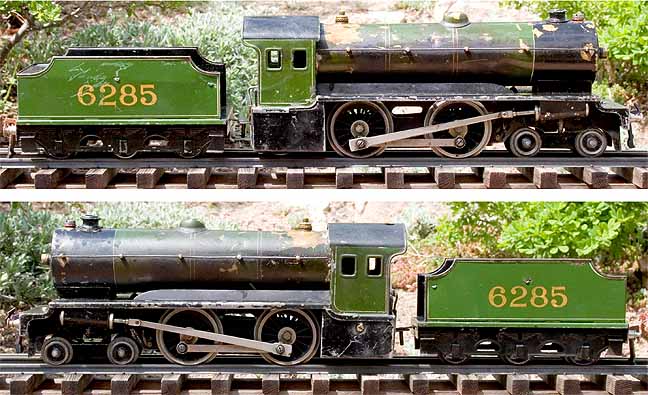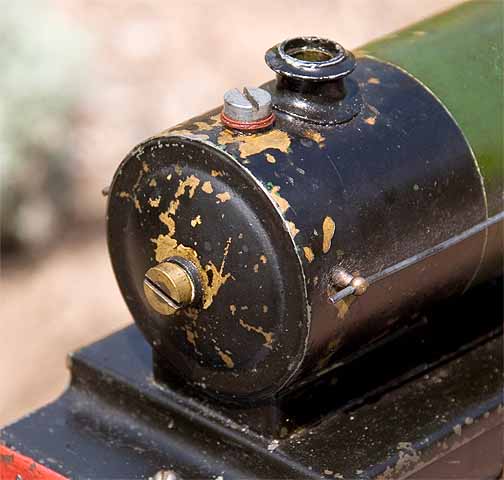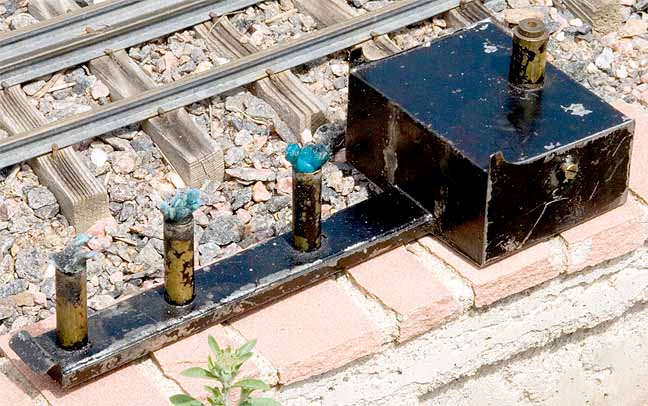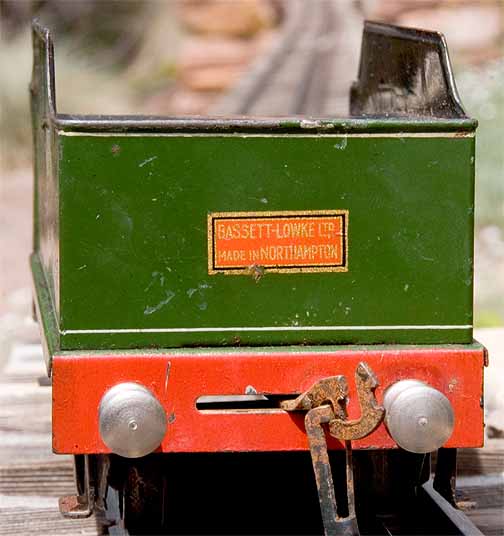
Back to Loco of the Month homepage
Back to Sidestreet Bannerworks
.
May 2009
Bassett-Lowke's "Enterprise"
by Marc Horovitz

Bassett-Lowke, the well-known British maker and importer of all kinds of railway gear in many scales and gauges, first produced this charming 4-4-0 in 1931. It was produced in green and red, and also in kit form in black. The number on the tender, "6285," was the phone number of Bassett-Lowke's shop in High Holborn, London.
The engine is nicely proportioned and might be considered semi-scale, despite its tinplate-like wheel flanges. Mechanically, it is unsophisticated, with a pot boiler and slip-eccentric valve gear driving piston-valve cylinders. The boiler is brass, with a blow-off pressure of around 15 psi. There is a safety valve atop the boiler, near the cab, and a whistle in the cab that protrudes through a hole in the roof and is actuated by a lever in the cab. No throttle is provided. Engine speed is governed by the weight of the train, the adjustment of the wicks, and the weather. The tender is purely ornamental, carrying neither water nor fuel.
My example was acquired on eBay. It was untested, so I knew I might be in for trouble. I could tell from the photos that it had seen a lot of use, but it appeared to be complete and the removable burner was intact. I figured that if something was amiss, I could set it right.
When the engine arrived, I tried it on air. It obviously wanted to go, but was exceedingly lumpy. Something was wrong, and I suspected valve timing. I consulted Murray Wilson, a person of vast experience in these matters, who advised me on resetting the valves. I followed his instructions, but to no avail. However, when working with the engine, I noticed that one cylinder was loose from its plumbing, all of which is soft-soldered in place on these engines. I mentioned the fact to Murray, saying that even though it was slightly loose, there didn't seem to be much leakage. He strongly advised me to see to that problem before going on to something else, so I did.
This involved unsoldering the cylinder from its remaining plumbing and unscrewing it from the frames. Once done, the cylinder came off in my hand. The problem then became degreasing it, as there was steam oil in the line, which contaminated the parts for soldering. After considerable trial and error, I got the parts clean. I reassembled them, then applied the heat, with some new solder. All went well.
Upon applying air to the boiler, the transformation was amazing. What had been a recalcitrant non-runner before became a smooth running, powerful engine. A steam test on blocks reinforced this opinion.
The run
I had always heard that these were fair-weather locomotives. The three-wick burner is pretty exposed under the boiler, with minimal shielding for the flame. That being the case, I chose a cool but relatively calm morning for steam trials. After preparing the engine in the usual way, I lit it up. In due course, steam came up. I pushed t along to clear the condensate, and then it took off under its own power. Since it had no throttle, it ran at whatever speed the steam generated would produce. In this case, it started out well, but then slowed and became lethargic. I suspected the wicks.
I removed the burner and pulled the wicks. These may have been the original wicks that came with the engine -- they were certainly old. In fact, they were cotton lamp wicks, rolled tightly and stuffed into the tubes. I replaced these with ceramic-fiber-rope strands and put the burner back in the engine.
The second try was a little better, but the result was ultimately similar. I removed the burner again, then removed a single strand of wick material from each tube. That did the trick. Despite the coolness of the day, the engine ran strongly throughout its run.
It is always gratifying to take something that someone else might consider a junker and make it live again. This locomotive, despite its tatty appearance, is a good. Many thanks to Murray Wilson for his sage advice.
Here's a movie of the engine in action. If it doesn't work, click here to go to YouTube.
|
|
|
| Builder | Bassett-Lowke, UK |
| Date built | 1930s |
| Gauge | 32 mm |
| Scale | 0 scale |
| Boiler | Pot |
| Fittings | Safety valve |
| Fuel | Alcohol |
| Blow-off pressure | 15 psi |
| Cylinders | Two, double acting, piston-valve |
| Reversing gear | Slip eccentrics |
| Lubricator | Displacement |
| Weight | 4 lb., 0 oz. |
| Dimensions (loco & tender) | Length, 16-3/4"; width, 2-1/2"; height, 4-1/4" |





Below: The burner is easily removed from the engine. The tank is a large, brass box that holds the fuel. The smaller, long box takes the fuel to the three wicks. Wicks are blue because of the food coloring in the meths.





Back to Sidestreet Bannerworks home page
This page and its contents
Copyright Sidestreet Bannerworks, 2009
.